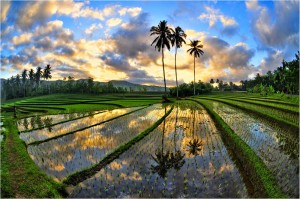 UNESCO has officially acknowledged Bali’s traditional subak agricultural system on its World Heritage List during the organization’s annual meeting in Saint Petersburg, Russia, on June 29. Subak, along with other historical sites such as the Church of the Nativity and the Pilgrimage Route in Bethlehem in Palestine, the Nahal Me’arot/Wadi el-Mughara Caves in Israel, as well as Rock Island’s Southern Lagoon in Palau, were all named as World Heritage Sites.
UNESCO has officially acknowledged Bali’s traditional subak agricultural system on its World Heritage List during the organization’s annual meeting in Saint Petersburg, Russia, on June 29. Subak, along with other historical sites such as the Church of the Nativity and the Pilgrimage Route in Bethlehem in Palestine, the Nahal Me’arot/Wadi el-Mughara Caves in Israel, as well as Rock Island’s Southern Lagoon in Palau, were all named as World Heritage Sites.UNESCO recognized subak as a Balinese cultural landscape of rice terraces and their water temples that cover 19,500 hectares. Subak reflects the philosophical concept of Tri Hita Karana, which brings together the realms of the spirit, the human world and nature. The subak system of democratic and egalitarian farming practices has enabled the Balinese to become the most prolific rice growers in the archipelago, despite the challenge of supporting a dense population. Included in the UNESCO-recognized landscape are the 18th-century royal temple of Pura Taman Ayun in Badung, the Batukaru mountain reserve in Tabanan, the Pakerisan watershed in Gianyar and Lake Batur in Bangli. The UNESCO acknowledgement, however, needs to be followed up by real action to preserve the sites. Many people will come to the sites. The government should manage them to anticipate the damage to the sites because of tourism The government should immediately draft regulations to prevent land conversion, as well as to protect the farmers. Nowadays, the government doesn’t have regulations about managing subak sites, causing massive land conversion Bali Cultural Agency head Ketut Suastika said that the government would follow up the UNESCO acknowledgement by drafting regulations to preserve subak and to develop a management system for the sites. “Together with the regional administrations, we will divide the sites and the surrounding areas into several zones. The regulation will cover zoning of the areas,” Suastika said, adding that the Bali administration had drafted a by law on subak as part of its attempt to preserve it as a central pillar of the Balinese culture. The government, he said, would also establish a special board to manage the world heritage sites. The board, he said, would meet stakeholders from all parties, such as the government, subak members, the tourism sector and academics. Meanwhile, many domestic and foreign tourists have visited the world heritage sites. via the bali daily
